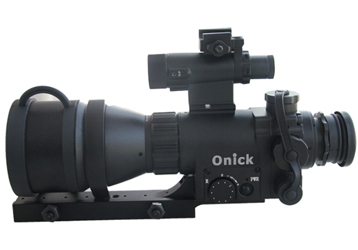The effective range of infrared night vision scopes is affected by many factors. The following is a specific analysis:
1. Active infrared night vision scopes
General situation
The effective range of active infrared night vision scopes is usually around 100-300 meters. Within this distance range, it can present the outline and details of the target object more clearly. This is because the infrared light emitted by itself can effectively illuminate the target within this distance, and the reflected infrared light can be well received and processed by the scope and converted into a clear image.
Influencing factors
Infrared light power: If the power of the infrared transmitter is large, the effective range may be farther. For example, some high-end active infrared night vision scopes have strong infrared light power. Under ideal conditions (such as high air transparency and no obstructions), the effective range can reach 400-500 meters.
Environmental conditions: In a clear, fog-free, and dust-free environment, the propagation of infrared light is less disturbed, and the effective range will be close to its nominal value. On the contrary, in foggy, rainy or dusty weather, infrared light will be scattered and absorbed, and the effective distance may be shortened to 50-100 meters, or even closer.
Target reflectivity: The reflectivity of the target object to infrared light is also critical. For example, white or light-colored targets have high reflectivity and can be found at a longer distance; while black or dark-colored targets have low reflectivity and the effective detection distance will be shortened. For example, a white hare in the snow may be found at 200-300 meters, while a black hare in the grass may not be observed until 50-100 meters.
2. Thermal imaging night vision scope
General situation
The effective range of thermal imaging night vision scope is relatively longer, generally reaching 500-1000 meters or even farther. This is because thermal imaging technology is based on the thermal radiation of the target itself to form an image, rather than relying on external light source illumination. As long as the temperature of the target is different from the background temperature, it can be detected.
Influencing factors
Target thermal contrast: If the temperature difference between the target and the background is large, the thermal imaging scope can detect the target at a longer distance. For example, on a cold night, the body temperature of warm-blooded animals (such as deer) is significantly higher than the surrounding environment, and they may be detected at a distance of about 1000 meters. However, if the temperature difference between the target and the background is small, the effective distance will be shortened. For example, on a hot day, the target and the ambient temperature are close, and the effective distance may be reduced to 200-300 meters.

Detector performance: The quality of the detector of the thermal imaging scope has a great influence on the effective distance. High-performance detectors have higher sensitivity and resolution, and can distinguish the details of the target at a longer distance. For example, some military-grade thermal imaging scopes have detectors that can identify targets of the size of a person at a distance of 1500 meters or even farther.
Atmospheric environment: Factors such as water vapor and dust in the atmosphere absorb and scatter thermal radiation, affecting the effective distance of thermal imaging. In an environment with high humidity or high dust, the effective distance will decrease, possibly from about 1000 meters to 500-700 meters.


